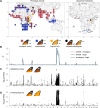Incomplete recombination suppression fuels extensive haplotype diversity in a butterfly colour pattern supergene
- PMID: 40019922
- PMCID: PMC11918383
- DOI: 10.1371/journal.pbio.3003043
Incomplete recombination suppression fuels extensive haplotype diversity in a butterfly colour pattern supergene
Abstract
Supergenes can evolve when recombination-suppressing mechanisms like inversions promote co-inheritance of alleles at two or more polymorphic loci that affect a complex trait. Theory shows that such genetic architectures can be favoured under balancing selection or local adaptation in the face of gene flow, but they can also bring costs associated with reduced opportunities for recombination. These costs may in turn be offset by rare 'gene flux' between inverted and ancestral haplotypes, with a range of possible outcomes. We aimed to shed light on these processes by investigating the 'BC supergene', a large genomic region comprising multiple rearrangements associated with three distinct wing colour morphs in Danaus chrysippus, a butterfly known as the African monarch, African queen and plain tiger. Using whole-genome resequencing data from 174 individuals, we first confirm the effects of BC on wing colour pattern: background melanism is associated with SNPs in the promoter region of yellow, within an inverted subregion of the supergene, while forewing tip pattern is most likely associated with copy-number variation in a separate subregion of the supergene. We then show that haplotype diversity within the supergene is surprisingly extensive: there are at least six divergent haplotype groups that experience suppressed recombination with respect to each other. Despite high divergence between these haplotype groups, we identify an unexpectedly large number of natural recombinant haplotypes. Several of the inferred crossovers occurred between adjacent inversion 'modules', while others occurred within inversions. Furthermore, we show that new haplotype groups have arisen through recombination between two pre-existing ones. Specifically, an allele for dark colouration in the promoter of yellow has recombined into distinct haplotype backgrounds on at least two separate occasions. Overall, our findings paint a picture of dynamic evolution of supergene haplotypes, fuelled by incomplete recombination suppression.
Copyright: © 2025 De-Kayne et al. This is an open access article distributed under the terms of the Creative Commons Attribution License, which permits unrestricted use, distribution, and reproduction in any medium, provided the original author and source are credited.
Conflict of interest statement
The authors have declared that no competing interests exist.
Figures




References
-
- Charlesworth B, Charlesworth D. Selection of new inversions in multi-locus genetic systems. Genet Res. 1973;21:167–83.
MeSH terms
LinkOut - more resources
Full Text Sources

